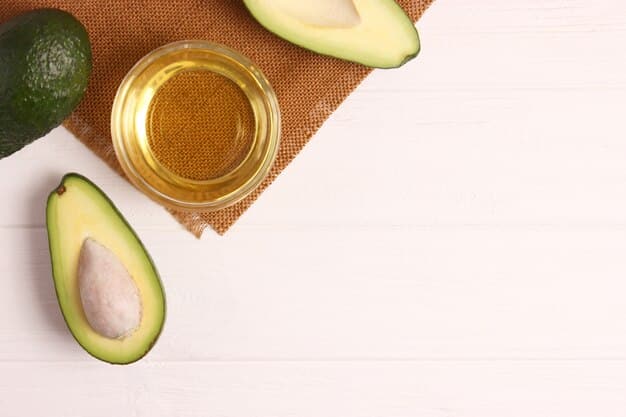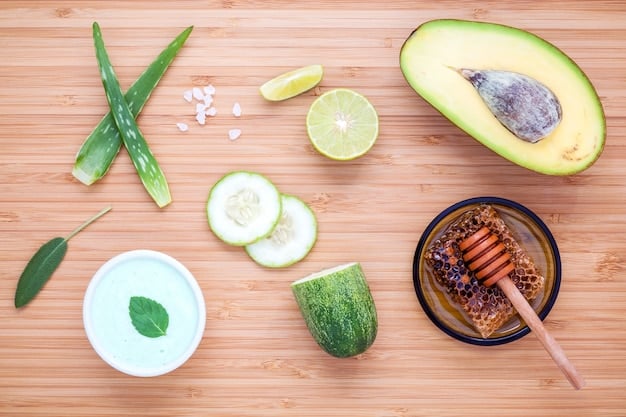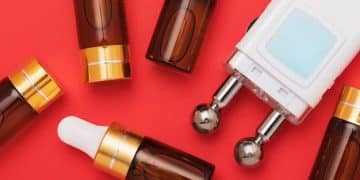DIY Skincare vs. Professional Treatments: Your 2025 Guide

Advertisements
DIY skincare and professional treatments both offer unique benefits in 2025, impacting your skin health; the best choice depends on your skin type, budget, and specific goals, requiring a comparison of personalized needs versus advanced solutions.
Advertisements
Navigating the world of skincare can be overwhelming, especially when deciding between at-home remedies and professional treatments. As we look towards 2025, understanding the nuances of DIY Skincare vs. Professional Treatments: Which is Right for You in 2025? becomes essential for achieving optimal skin health.
Understanding the Basics of DIY Skincare
Advertisements
DIY skincare involves creating your own skincare products using ingredients you can find at home or easily purchase. This approach allows for customization and control over what you put on your skin.
What Constitutes DIY Skincare?
DIY skincare primarily involves using natural ingredients to address skin concerns. It’s a budget-friendly alternative to store-bought products and professional treatments.
Benefits of DIY Skincare
One of the main advantages is the ability to personalize formulations based on your skin’s specific needs. Plus, it can be a fun and creative way to take care of your skin.
- Cost-Effective: Often cheaper than high-end products or professional services.
- Customizable: Tailor ingredients to your skin type and concerns.
- Natural Ingredients: Avoid harsh chemicals and artificial additives.
- Environmentally Friendly: Reduce packaging waste and support sustainability.
However, it’s crucial to be well-informed about ingredients and their potential effects on your skin. Always perform patch tests and research thoroughly.
In summary, DIY skincare offers a personalized and cost-effective route to skincare, but it also requires diligent research and caution to ensure safety and effectiveness.

Exploring Professional Skincare Treatments
Professional skincare treatments are administered by trained estheticians or dermatologists. These treatments often involve advanced technologies and medical-grade products.
Types of Professional Treatments
From laser therapies to chemical peels, professional treatments offer intense solutions for various skin issues. They are designed to deliver noticeable results.
Advantages of Professional Treatments
The expertise and precision of professionals often lead to faster and more effective outcomes compared to DIY methods. Plus, treatments are tailored to your skin condition.
- Expertise: Performed by trained and licensed professionals.
- Advanced Technology: Access to cutting-edge tools and techniques.
- Customized Care: Tailored treatments based on skin analysis.
- Effective Results: Often provides quicker and more dramatic improvements.
While these treatments can be more expensive, the expertise and specialized products often justify the cost for those seeking significant improvements.
Ultimately, professional skincare treatments provide expertise and advanced solutions for those seeking effective and targeted improvements, though they often come at a higher cost.
Assessing Your Skin Type and Concerns
Understanding your skin type and specific concerns is crucial before choosing between DIY and professional approaches. Knowing your skin is the foundation for effective skincare.
Identifying Your Skin Type
Determining whether you have oily, dry, combination, or sensitive skin will guide your choice of products and treatments. Each skin type has unique requirements.
Common Skin Concerns
Addressing issues like acne, aging, hyperpigmentation, or sensitivity requires understanding the underlying causes. Matching treatments to these concerns is key.
- Oily Skin: Focus on oil control and preventing breakouts.
- Dry Skin: Prioritize intense hydration and moisture retention.
- Combination Skin: Balance oil production while hydrating dry areas.
- Sensitive Skin: Opt for gentle, non-irritating ingredients.
By accurately identifying your skin type and concerns, you can make informed decisions about whether DIY remedies or professional treatments are more appropriate.
To summarize, accurately assessing your skin type and specific concerns is paramount for making informed skincare decisions, guiding you toward the most effective solutions.
Comparing Costs: DIY vs. Professional Options
The financial aspect is a significant consideration when choosing between DIY and professional skincare. Both paths involve investments, but the scale can vary greatly.
DIY Skincare Costs
DIY skincare costs primarily involve purchasing ingredients like oils, clays, and essential oils. The initial outlay can be relatively low.
Professional Treatment Costs
Professional treatments often come with higher upfront costs due to the expertise, technology, and medical-grade products used. However, results might justify the expense.
- Initial Costs: DIY skincare typically has lower start-up costs.
- Long-Term Expenses: Professional treatments may have long-term maintenance costs.
- Product Quality: Both DIY and professional skincare rely on product quality.
- Hidden Costs: DIY may incur costs from errors or ineffective ingredients.
Ultimately, both DIY and professional options involve financial considerations, and the best choice depends on your budget and desired results.
In conclusion, both DIY and professional skincare require careful cost analysis, and the right approach depends on balancing your budget with your skincare goals.

Evaluating Risks and Potential Complications
Both DIY and professional skincare carry potential risks. Understanding these risks is crucial for making informed decisions and minimizing adverse effects.
DIY Skincare Risks
DIY skincare risks include allergic reactions, infections, and skin irritation from improper formulations or contaminated ingredients. Careful preparation is essential.
Professional Treatment Risks
Professional treatments can lead to side effects like redness, swelling, and hyperpigmentation, especially if not performed correctly. Thorough research and professional consultation are important.
- Allergic Reactions: Both DIY and professional treatments can trigger allergies.
- Infections: Poor hygiene in DIY or improper technique in professional treatments can cause infections.
- Skin Irritation: Incorrect ingredient usage or aggressive treatments can lead to irritation.
- Long-Term Effects: Professional treatments may have lasting side effects if not handled appropriately.
By understanding these risks, individuals can take steps to minimize potential complications. Always seek guidance from professionals when in doubt.
In summary, recognizing and mitigating the risks associated with both DIY and professional skincare is essential for safeguarding skin health.
Future Trends in Skincare (2025 and Beyond)
As we move towards 2025, the skincare landscape is evolving with new technologies and approaches. Staying informed about these trends will help you make the best choices for your skin.
Technological Advancements
Emerging technologies like AI-powered skincare analysis and personalized devices are set to revolutionize skincare. These advances offer more customized and precise treatments.
Sustainability and Ethical Concerns
More consumers are prioritizing sustainable and ethical skincare practices. Choosing eco-friendly and cruelty-free products is becoming increasingly important.
- Personalized Skincare: Customized formulations based on your unique skin profile.
- AI-Driven Analysis: Using artificial intelligence to analyze skin conditions for accurate recommendations.
- Tele-Dermatology: Remote consultations with dermatologists for convenient and timely advice.
- Sustainable Practices: Eco-friendly packaging, natural ingredients, and cruelty-free products.
Staying informed about these trends enables you to make forward-thinking decisions that align with your values and deliver optimal results.
In conclusion, keeping up with future trends in skincare ensures you are equipped to make informed and sustainable choices for maintaining healthy skin.
| Key Aspect | Brief Description |
|---|---|
| 💰 Cost | DIY is generally cheaper upfront, while professional treatments can be costly. |
| 🧪 Expertise | DIY relies on personal research; professional treatments benefit from expert knowledge. |
| 🌱 Ingredients | DIY typically uses natural ingredients, while professional treatments may use medical-grade formulas. |
| ⏱️ Results | Professional treatments often offer quicker, more dramatic results compared to DIY. |
Frequently Asked Questions
▼
DIY skincare can be safe if you research ingredients and perform patch tests. However, those with sensitive skin should proceed with caution and consult a dermatologist.
▼
The frequency of professional treatments varies depending on the specific treatment and your skin’s needs. Consult with a skincare professional for personalized advice.
▼
Yes, but it’s essential to ensure the DIY products and professional treatments are compatible. Avoid using harsh ingredients or over-exfoliating your skin.
▼
Using expired ingredients in DIY skincare can lead to skin irritation, bacterial contamination, and reduced effectiveness of the product. Always check expiration dates.
▼
AI can analyze your skin, recommend personalized products, and track progress. It can also provide insights and advice to optimize your routines and improve skin health.
Conclusion
Choosing between DIY skincare and professional treatments in 2025 depends on your individual needs, skin type, budget, and commitment to research and safety. By carefully evaluating these factors and staying informed about future trends, you can make the best decision to achieve healthy, radiant skin.





